Missing our blog posts? We’re missing your views!
We’re still posting content and pest prevention tips!
Access all of our current and future blogs at: Safeway Blog
 With the hustle and bustle of the holidays, you may find yourself not paying as much attention to the details of pest prevention. So, how about we save you some time and give you a few simple things to watch for to avoid a visitation from intrusive pests over the holiday season? Done!
With the hustle and bustle of the holidays, you may find yourself not paying as much attention to the details of pest prevention. So, how about we save you some time and give you a few simple things to watch for to avoid a visitation from intrusive pests over the holiday season? Done!
Check the Green Garnishments
Living decorations bring the beauty of nature into your home, but sometimes they bring in a little too much nature (remember the squirrel in the tree in National Lampoon’s Christmas Vacation?). Trees, wreaths and other live decorations can harbor hitchhikers such as spiders, moths and other pests. Therefore, it’s wise to inspect and shake live greenery out before bringing the decorations into your home.
Inspect Ornament Boxes
The joy of opening those holiday storage boxes that have been sitting in the basement or attic all year long can quickly become a nightmare if they weren’t stored properly. To keep from bringing any critters into your main living area, check and unpack items from boxes while they are still in storage for signs of pests such as droppings, chewed cords and gnaw marks.
After the holidays, give yourself some bonus gifts and repack your decorations in brand new, tightly-sealed storage containers and save yourself from surprises next year.
A Final Tip to Warm Up To…
If your holiday plans include snuggling up next to the fire and sipping your choice of holiday cheer, remember to inspect your firewood for any pests before bringing it indoors.
Outdoor tip: Storing firewood at least 20 feet from your home and on a raised structure will help keep pests out of your firewood.
If you’re in need of professional assistance with a pest issue, give us a call at our Muskego office at 262-679-4422, our Oshkosh office at 920-385-0412 or toll free at 800-956-0800.
Visit us on the web at: Safeway Pest Management
Filed under mice, Pest Prevention, Rodents, Spiders, Uncategorized
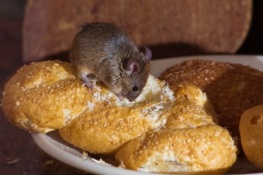
As winter sets in, chances of a rodent sighting in your home will rise as rodents attempt to find their way indoors to escape the cold. Being that mice can be destructive and can also spread disease, it’s important to learn identification facts to safeguard your home.
Droppings– Droppings are one of the most obvious sign of a mouse infestation. Dropping pellets tend to be tiny (about ¼ inch), black, and numerous. You may find waste matter around nesting sites, in food storage areas, on shelving, floors or counters. If you’re looking for additional waste clues, mouse urine will show up under ultraviolet light.
Route Rub Marks– Mice tend to use the same routes and travel against walls when navigating, this leaves dirty grease smudges on walls, floors and baseboards (from their oily fur). You may also notice urine spots on those same routes.
Scent and Sounds-Open a cupboard and get a whiff of a distinctive smell? A strong ammonia odor (the scent of urine) may be obvious, especially in enclosed areas.
Noticing any scratching sounds? You may hear scurrying noises in walls and ceilings, especially at night when mice are most active.
Did You Know: Mice can enter your home through a hole the size of a dime!
Gnawing Damage-Mice have teeth that continuously grow and so they like to gnaw to keep their teeth shorter. Gnaw marks and holes can be found on plastic and wood and most dangerously, on electrical wires which can be a fire hazard.
Food storage sites can also be areas in which to see gnaw marks. Mice will chew up boxes and contaminate stored food items.
Noticeable Nests– House mice shred paper and other soft materials, such as cotton, wall material and insulation for nesting sites. Good hiding places for nests include: cabinets, in dishwashers, behind refrigerators, ceilings, wall voids and other dark storage areas. Usually young mice will be present within the nesting site.
Eek! I’ve seen a mouse!-Lastly, you may spot live or dead mice around your home. Typically, if you see one, there’s most likely more.
Did You Know: a female house mouse can give birth to a half dozen babies every three weeks and can produce up to 35 young per year.
There are ways you can prevent an infestation in your home by:
If you’re in need of professional assistance with a pest issue, Give us a call at our Muskego office at 262-679-4422, our Oshkosh office at 920-385-0412 or toll free at 800-956-0800.
Our blog has a new home, follow future blogs at: Safeway Blog
Filed under mice, Pest Prevention, rats, Rodents, Uncategorized
Your Fall Pest-Proofing Checklist 
With autumn right around the corner, and insects soon ready to find the warmth around your home, this is the best time to check off some chores from your fall pest-proofing checklist! Below are some preparations you can make to your home to prevent pests from invading your home this fall and winter.
Our licensed and certified pest specialists can inspect your home for you and treat your home if need be. Call Safeway Pest Management at 262-679-4422 or 800-956-0800.
You can also visit our website at www.safewaypest.net
Filed under Ants, Asian Ladybeetles, Cluster Fly, Flies, mice, Pest Prevention, Rodents, Spiders, Uncategorized
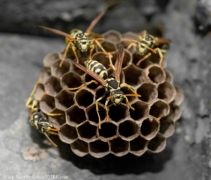
In discussions with our clients, sometimes we run into some common situations that require some advice regarding stinging insects. With your family’s safety in mind, we are taking this opportunity to highlight some of those frequently visited circumstances and offer some helpful solutions.
Situation: Using a pressure washer or hose to spray down an active stinging insect nest around your home.
What Happens: Flooding a nest with water may make the nest fall, but typically it will not kill the insects, at least not all of them. It will however make them more aggressive and potentially cause an attack in response. Doing this may also flooding or water damage to areas around your home. The remaining stinging insects will rebuild the nest in a nearby location soon after you destroy their nest.
Solution: The nest needs to be treated before it can be knocked down or removed. For safety reasons, it’s best to have a licensed and certified technician perform the treatment.
Situation: Plugging entrance holes in an active stinging insect nest.
What Happens: It’s a common misconception that by simply plugging the doorway to a nest, the insects will simply leave and move on. Some may even go as far as treating the nest with a store bought liquid insecticide and then plugging the hole directly afterward. What really occurs is that the insects, by using light as a guide, will easily find another way to enter and exit the nest. Sometimes the new entrance ends up being in an even worse location, such as when a plugged outdoor entrance causes the insects to create a new entrance, which leads them into your home. You will also find that the stinging insects will also grow more aggressive if you block their entrance.
Solution: If you call to have the nest professionally treated, you may need to revisit the nest in the evening (when it is safest) to unplug the entrance hole so that nest can be treated through that access point. When a professional treats a nest, the product used will penetrate the nest more deeply and tend to be effective on the first application. If the nest is professionally treated, it should not be plugged or removed until completely certain that the nest is in an inactive state.
Bonus Situation: You’re walking around your yard and stumble onto an active ground bee nest.
Solution: Ground bee nests are easier to spot than you think. Regularly check your yard for conical shaped holes with piles of dirt surrounding them. Sometimes several holes can be found relatively small area. If you do find nests in an unsafe area, avoid them and give a professional a call for control and treatment advice.
At Safeway Pest Management, our technicians are licensed and trained to safely deal with stinging insects and their nests. If you’re hearing buzzing, or see a nest, call Safeway Pest Management at 262-679-4422 or 800-956-0800
You can also visit our website at www.safewaypest.net
Filed under Pest Prevention, Stinging Insects, Uncategorized
People easily confuse bees with yellow jackets and hornets with wasps, probably because in most cases we are trying our best to keep our distance. But, when dealing with a sting or a threatening nest around your home, identifying information can be pretty handy. We will do our best to help you figure out which stinging insect and nest is which.
First off, here’s some general stinging insect knowledge regarding bees and wasps.
Bees: Have two pairs of wings, relatively hairy, long antennae and are important pollinators.
Wasps: Have two pairs of wings, relatively hairless, long antennae, most have a thin “waist”, many have bright orange and yellow colors (stripes on legs, abdomen or thorax) Wasps include both yellow jackets and hornets.
Most species of wasps are predators.
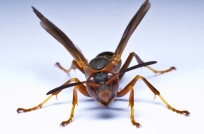 Paper wasps have smooth bodies, usually dark brown with yellow markings and a slender waist. When paper wasps are flying they can be recognized by two rear legs “hanging down”. Paper wasp nests are made of paper-like combs and found hanging under eaves, door frames, soffits, deck rails, roofs, porches, trees, shrubs.
Paper wasps have smooth bodies, usually dark brown with yellow markings and a slender waist. When paper wasps are flying they can be recognized by two rear legs “hanging down”. Paper wasp nests are made of paper-like combs and found hanging under eaves, door frames, soffits, deck rails, roofs, porches, trees, shrubs.
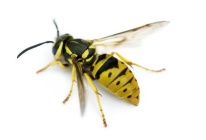
Yellow jackets are a type of predatory wasp. Most yellow jackets are black and yellow, but some are black and white, like the bald-faced hornet. Yellow jackets tend to fly in a side to side motion and are very aggressive. Since they have stingers with barb, their sting is often very painful. Yellow jacket nests are made of paper with a single hole in the bottom, they nest in wall voids, rodent burrows, eaves, and other locations that are easily hidden from predators.
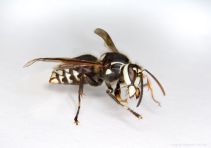 Hornet is a loosely used word to typically identify the bald-faced hornet, which is the largest of the wasps. Bald-faced hornets are yellow and black or white and black, look similar to the yellow jacket, but longer and thinner. Hornets are aggressive when defending their nest and sting repeatedly. They build their nests entirely on the exterior and out in the open and the nests are football-shaped and out of reach in high eaves, under decks and in trees and shrubs.
Hornet is a loosely used word to typically identify the bald-faced hornet, which is the largest of the wasps. Bald-faced hornets are yellow and black or white and black, look similar to the yellow jacket, but longer and thinner. Hornets are aggressive when defending their nest and sting repeatedly. They build their nests entirely on the exterior and out in the open and the nests are football-shaped and out of reach in high eaves, under decks and in trees and shrubs.
A Bonus Predator-The Cicada Killer Wasp
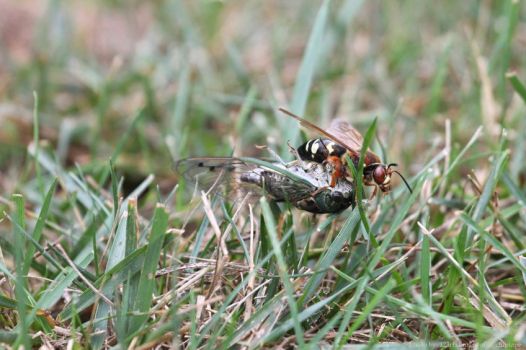
Recently, a predator has made its presence known in our area. The cicada killer wasp has been found nesting in at least one of our southern-most counties. These solitary wasps choose sites with specific characteristics to nest, they like well-drained, light-textured soils in full sunlight that are near trees harboring cicadas. At 1-2 inches long, their size tends to be a bit intimidating. Luckily, the cicada killer wasp is more of a docile insect, unless you have the unfortunate luck of being a cicada. The female wasp is known for snatching a cicada right in mid-air, then using the stinger it injects venom that will paralyze its victim so that the victim cicada can be taken back to the nest to deposit an egg into. The egg will then hatch and feed on the cicada before maturing to adulthood.
Although docile, stings to humans and pets can occur if you happen to accidentally stumble upon one.
At Safeway Pest Management, our technicians are licensed and trained to safely deal with stinging insects and their nests. If you’re hearing buzzing, or see a nest, call Safeway Pest Management at our Muskego office at 262-679-4422, at our Oshkosh office at 920-385-0412 or toll free at 800-956-0800
You can also visit our website at www.safewaypest.net
Filed under Stinging Insects, Uncategorized
 Summer gatherings are one of the highlights of the warm months, but they are best done without the addition of creepy, crawly uninvited guests. Insects such as mosquitoes can cause annoying bites and can potentially transmit dangerous diseases and stinging insects can pose a threat to guests with allergies.
Summer gatherings are one of the highlights of the warm months, but they are best done without the addition of creepy, crawly uninvited guests. Insects such as mosquitoes can cause annoying bites and can potentially transmit dangerous diseases and stinging insects can pose a threat to guests with allergies.
Following the tips below will help keep your outdoor cookout pest-free and allow you to sit back and enjoy your gathering time.
Pre-Cookout Yard Inspection and Clean-Up
Inspect your yard for any potential insect problems such as ant hills or stinging insect nests. Call a professional pest management company if needed.
Mow the grass the day before a cookout can help reduce harborage for insects hiding in taller grass, such as ticks.
Drain any standing water sources to prevent the breeding of mosquitoes.
Pick up leaves, sticks and any fallen fruit that may attract insects from your yard and out of your gutters.
Make sure trash is properly stored in a covered container.
During the Cookout
Have on hand an EPA approved repellent with DEET to ward off mosquitoes.
Remind guests (even make a sign) to close doors tightly when entering and exiting your home to prevent mosquitoes from coming inside.
If you’re attending a cookout, have a change of clothes along. If the weather allows for it, long sleeves and long pants will protect from bites from mosquitoes.
Avoid wearing perfumes or fragrances that will attract insects.
Have plastic cups available for use. Beverage cans and bottles are attractants for stinging insects.
Keep food tightly sealed and covered and/or keep food in sealed coolers.
Keep food prep areas clean and immediately wipe up any spills. Ants and flies are especially attracted to leftover food remnants.
Keep trash in covered receptacles. Keep trashcans away from main gathering areas.
Use fans to create a breeze that will keep insects away.
If you’re in need of professional assistance with an insect issue, give us a call at our Muskego office at 262-679-4422, our Oshkosh office at 920-385-0412 or toll free at 800-956-0800.
Visit our website at www.safewaypest.net
Filed under Ants, Flies, Fruit Fly, Mosquito, Pest Prevention, Stinging Insects, Ticks, Uncategorized
After months of shivering, we embrace spring and the warmer breezes, but maybe not everything that blows in with the season. Pest invaders are pretty quick to get moving once the temperatures rise. Some insects you’re sure to see early on include: Boxelder bugs, Asian ladybeetles, ticks, ants and mosquitoes.
According to NPMA’s Bug Barometer, ticks and mosquitoes (along with ants) will be on the rise in numbers this year. We offer a Mosquito program that can aid in reducing numbers of both pests, while protecting your yard and family from these dangerous nuisances.
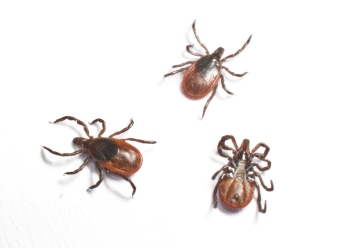
Three female Blacklegged ticks-NPMA
Ticks
Ticks are not insects. Ticks are actually arachnids like spiders, scorpions and mites. Unlike insects, all members of this group have 4 pairs of legs as adults, and haven’t any antennae. Ticks do not fly or jump. They will crawl onto grass or brush until they find a host to crawl up and attach to. It is thought that ticks also have the ability to wait on higher ground and drop onto a host. Ticks are in need blood to survive. They will bury themselves deep within a host and can stay attached for days to eat. A quick tick check after being outdoors and a prompt removal of a tick is important. Ticks transmit a wide array of disease-causing microbes, with Lyme disease as the highest reported tick-borne illness in Wisconsin.
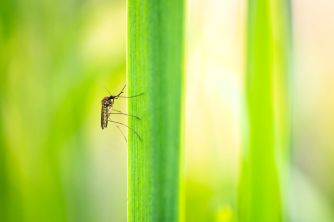
Mosquito
Mosquitoes
Mosquitoes have been labeled as one of the deadliest killers in the world. Mosquitoes like to breed in stagnant water and have an extremely fast life cycle, which allows for quick growth in population. Mosquitoes are vectors of numerous diseases including malaria, yellow fever, dengue fever, encephalitis, La Crosse encephalitis and, of course, West Nile virus.
Our Mosquito Program will give you protection all season long for only $380.00*. Contact our Muskego office at 262-679-4422, Oshkosh office at 920-385-0412 or toll free at 800-956-0800 for more information or to sign up for this beneficial program that will give you and your family Peace of Mind.
*Price is for 1 acre or less. See additional details on our Website.
Filed under Ants, Asian Ladybeetles, Box Elder Bugs, Mosquito, Pest Prevention, Ticks, Uncategorized
With the spring season upon us and a prediction from the National Pest Management Association (NPMA) of a larger tick population this year, it’s a good time to revisit some helpful tick truths and tips.
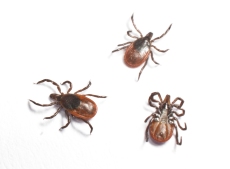
Three female Blacklegged ticks-By: NPMA
Call our knowledgeable staff now in Muskego at 262-679-4422, in Oshkosh at 920-385-0412 or toll free at 800-956-0800 to request a free estimate and ask us about our 4 Tier Mosquito Program, which also targets ticks. Visit us on the web at www.safewaypest.net.
Filed under Pest Prevention, Ticks, Uncategorized
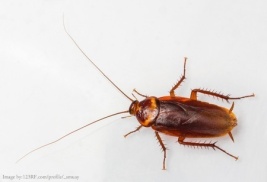
American Cockroach
It’s a little creepy to learn that over 4,000 species of cockroach exist in the wide world! Thankfully, out of those thousands, only a small number of them reside in Wisconsin.
Cockroaches are considered a dangerous pest due to the potential for health risks. Cockroaches pick up and carry a multitude of bacteria, spread diseases such as E Coli and Salmonella, and are triggers for allergy and asthma sufferers.
The three species of cockroach that are most prominent in Wisconsin are the Oriental cockroach, the American cockroach and the German cockroach. Cockroaches range in color from light brown to black and can vary in size from 1/4 of an inch to 2 inches long depending on the species.
Creepy Cockroach Fact: A cockroach can live for a week without its head!
Where Do They Hide?
Cockroaches are attracted to dark and damp locations that are close to food and water sources. They are commonly found in kitchens and bathrooms, and they are good at hiding. Cockroaches can be found lurking behind refrigerators, under sinks, in appliances and under floor drains. Cockroaches will scatter and run for shelter whenever a light switch is turned on.
How Do I Know I Have Them?
Cockroaches will leave behind feces, which resemble little black specks, much like coffee grounds. In a severe infestation, a musty odor may be found, and/or the presence of dead cockroaches.
Creepy Cockroach Fact: Cockroaches can run up to 3 miles per hour, which means they can rapidly spread bacteria throughout a home.
How Do I Prevent Them?
The prevention of cockroaches has much to do with sanitation. Keeping food areas clean, reducing moisture sites and maintaining proper sanitation are tactics best used to reduce the probability of the attraction of cockroaches.
Once a cockroach problem has been established, eradication can be difficult. It’s best to contact a pest specialist to inspect and determine the best treatment option.
If you’re in need of professional assistance with a cockroach issue, give us a call at our Muskego office at 262-679-4422, our Oshkosh office at 920-385-0412 or toll free at 800-956-0800.
Visit our website at www.safewaypest.net
Filed under cockroaches, Pest Prevention, Uncategorized